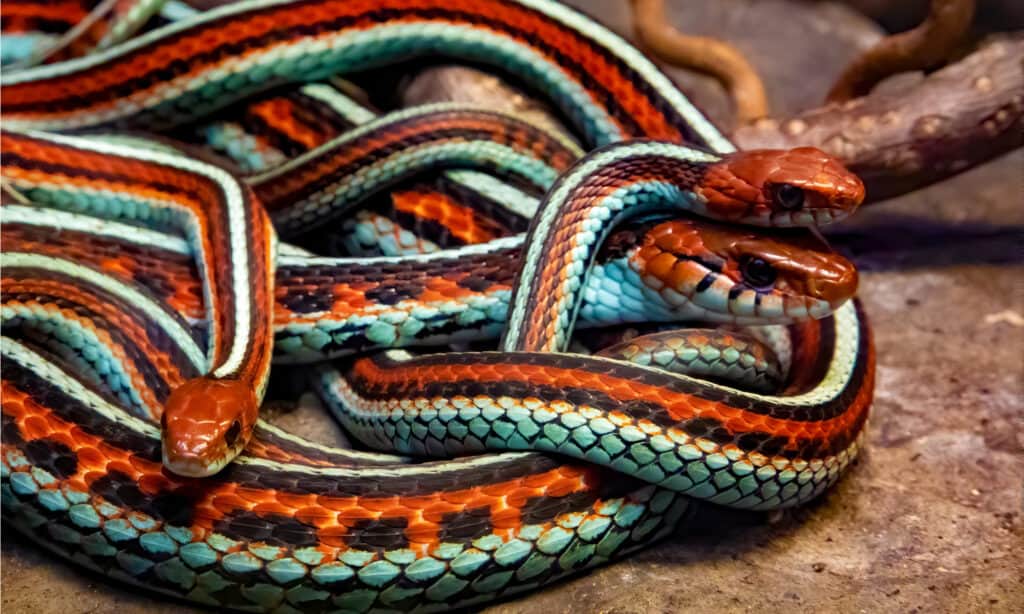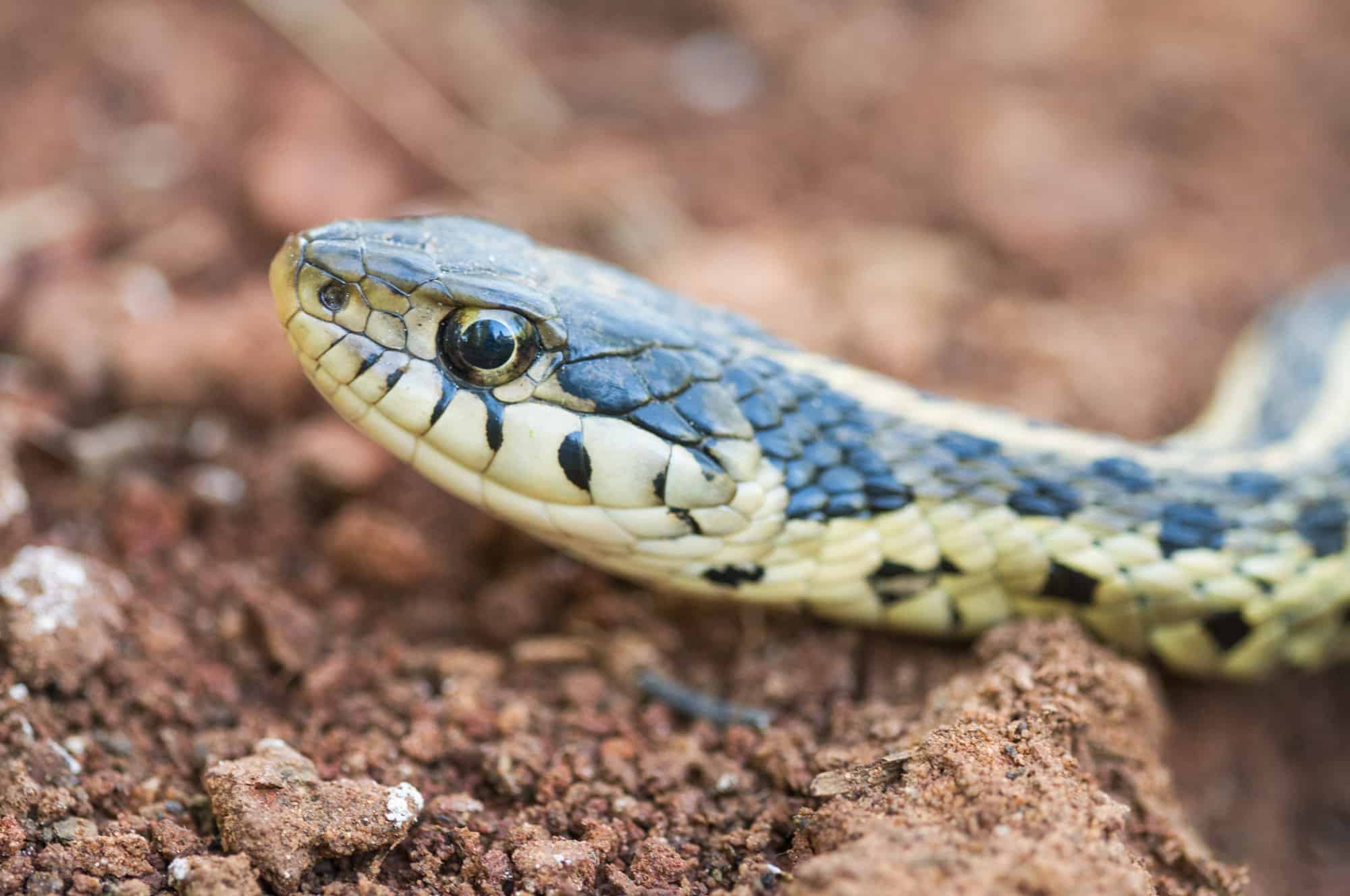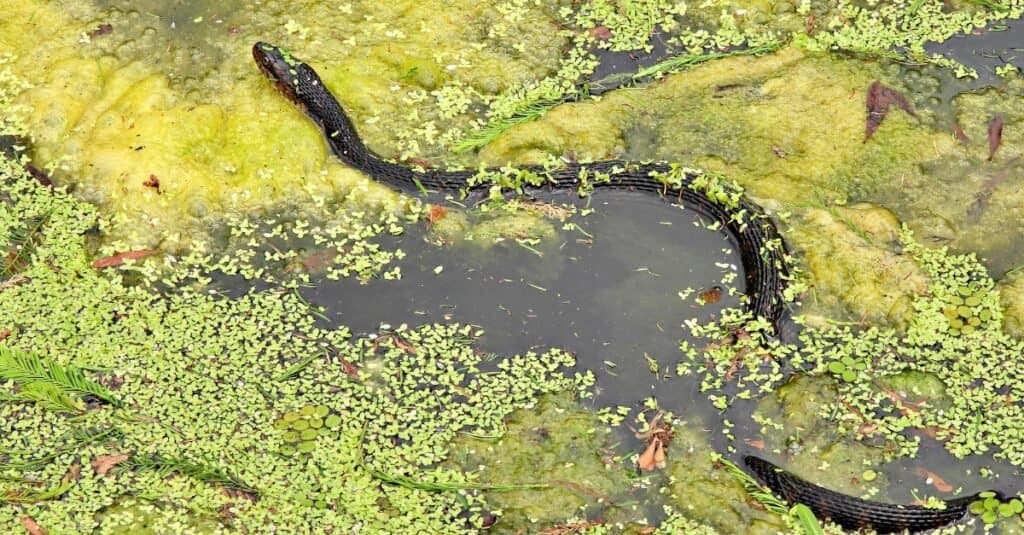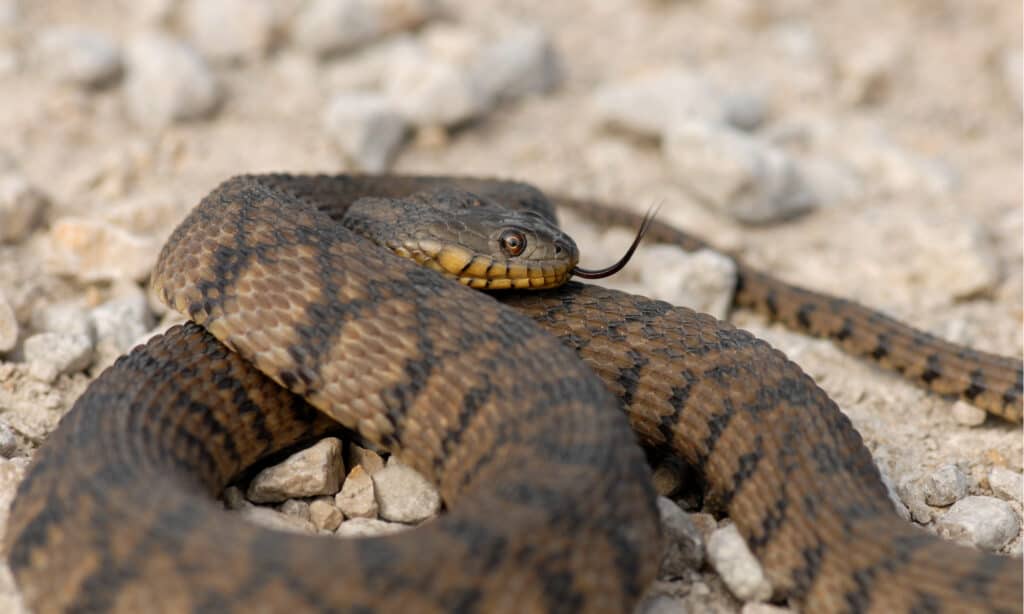Key Points:
- Garter snakes and water snakes are semiaquatic snakes in the Natricinae subfamily.
- These snakes are not dangerous to people, but some may have toxic saliva that’s dangerous to their prey.
- Water snakes from the Nerodia genus have been introduced in a few areas but aren’t widespread.
- Garter snakes are one of the most successful and variable snake species in North America.
With around 50 types of snakes, the Golden State may be one of the most snake-populated states in the United States. Although all snakes can swim, not all of them are water snakes. Regardless, California is no slouch in the aquatic snake game. There are several garter snake species and subspecies. In addition, a few other water snake species have been introduced. Let’s explore!
Water Snakes in California
Strictly speaking, California doesn’t have any native water snakes — if we’re only counting those in the Nerodia genus that have “water snake” in their common names. However, the eight or so garter snake species plus several subspecies are close cousins and share many behaviors. Most garter snakes prefer being close to water, but are also found some distance from a water source.
Garter Snakes
These slender, harmless-to-humans reptiles favor small amphibians, earthworms, slugs, and sometimes fish in their diet. Garter snakes are sometimes called ribbon snakes, depending on which species within the Thamnophis genus you’ve found.
California’s garter snakes vary from the small but beautiful California red-sided garter (Thamnophis sirtalis infernalis) to the over five-foot-long giant garter snake (Thamnophis gigas). One thing that most garter snakes share is a light-colored dorsal stripe, which can be yellow, cream, red, orange, or even blue. Many also have similar stripes on each flank, but those are sometimes more subtle.
Snakes in this genus are the closest you’ll find in California to a native water snake. They’re part of the Natricinaesubfamily in the larger Colubridae family. These snakes prefer wet areas like rivers, lakes, and marshes. And, like most of their cousins, they give birth to babies during the summer.
California Garter Snake Species
While the most common species, like the common garter snake, are your most likely finds, a few are uniquely beautiful and deserve a special mention.
San Francisco Garter Snake (Thamnophis sirtalis tetrataenia)

San Francisco garter snakes, endemic to the San Francisco Peninsula of California, have small, slender bodies measuring an average of 3 feet.
©spatuletail/Shutterstock.com
One of the more beautiful garter snakes, the San Francisco garter snake boasts blue-green dorsal scales with black, red, blue-green, or orange stripes and a red head. It’s a larger subspecies and can grow up to four and a half feet long.
San Francisco garter snakes are extremely shy, but are relatively common in the wetlands of the San Francisco Peninsula.
Two-Striped Garter Snake (Thamnophis hammondii)

Two-striped garter snakes are highly aquatic and have two variants: one with lateral stripes and the other one like this individual with a checkered pattern in place of the stripes.
©Jason Mints/Shutterstock.com
Owing to its distinct lack of dorsal stripe, the two-lined garter snake isn’t always recognized as a garter snake. Sometimes, they lack even the flank stripes and have a checkered pattern — two rows of small dark spots on each side where the stripes would normally be located.
Size-wise, these snakes fall into the middle of garter snakes — maxing out at 30 inches. They range from central California south into Baja California, Mexico. This snake is highly aquatic and primarily eats amphibians and fish.
Giant Garter Snake (Thamnophis gigas)
This snake used to occur along the edges of freshwater marshes, tributaries, and flood basins in California’s central valley from Butte County south to Kern County. Their range is smaller now and they’re only found as far south as Fresno County.
Giant garter snakes are one the biggest garter snake species. Growing up to 63 inches, they’re an impressive size for a garter snake. Slender with a small head, they have round pupils. Giant garter snakes are olive to brown with an orange, yellow, or cream dorsal stripe and two lighter stripes on their flanks.
It’s listed as a threatened species and is becoming rare. Their main challenge is habitat loss and fragmentation, including converting rice production to orchards.
Marcy’s Checkered Garter Snake (Thamnophis marcianus marcianus)

Checkered garter snakes have round eyes with black pupils.
©James Brunner Photography/ via Getty Images
This checkered garter snake subspecies usually only occurs in Riverside and Imperial counties. Unlike other garter snakes, Marcy’s checkered garter snake is more active at night than during the day.
A smaller species, Marcy’s checkered garter snake is only about 28 at its biggest. It’s tan, yellowish brown, or brown with rows of blotches that form a checker board pattern between its stripes.
Marcy’s checkered garter snake mostly eats amphibians, but also eats fish, invertebrates, snakes, mammals, and lizards.
Other Garter Snakes
Garter snakes vary widely in color and pattern. They’re one of the most widespread and successful snake types in North America, so it’s probably not a surprise to find several species in California. Here are a few more:
- Santa cruz garter snake (Thamnophis atratus atratus)
- Mountain garter snake (Thamnophis elegans elegans)
- Coastal garter snake (Thamnophis elegans terrestris)
- Valley garter snake (Thamnophis sirtalis fitchi)
- California red-sided garter snake (Thamnophis sirtalis infernalis)
Introduced Water Snakes
A water snake is any snake in the Nerodia genus. Just like garter snakes, water snakes are members of the Natricinae subfamily. They’re not native to California, but occur in a few spots.
Some people think they were released or escaped pets, while others believe they may have hitched a ride on a truck or three. No one is certain how water snakes found their way into California, but they did.
Three water snake species are known to inhabit a few areas of California. Scientists are concerned that their population will grow and begin out-competing native animals — similar to the Burmese and rock python problem in Florida.
Where they differ most from garter snakes are their color patterns, body styles, and amount of time spent in the water.
Water snakes like the common, banded, and diamondback water snakes are heavy-bodied and almost black or dark green as adults. In their native areas, their range often overlaps with venomous cottonmouths — and because of their similarities are often confused with that species. However, where the pit vipers have vertical pupils, water snakes do not — they have round pupils, vertical labial (lip) bars, and keeled scales.
Generally between two and four and a half feet long, all three species are thick-bodied for their length. Although they’re nonvenomous, water snakes have a nasty bite — razor sharp teeth designed for capturing slimy prey don’t feel great on your skin.
Water Snakes in California
If you’ve spent time in the eastern United States, you’ve probably seen or heard of water snakes.
So far, water snake sightings are limited to three or four areas in the state. Most of them don’t have breeding populations. Fortunately, water snakes often live alongside garter snakes in their native habitats, so it’s possible that they won’t become invasive.
Florida Water Snake (Nerodia fasciata pictiventris)

Found in many of the bodies of water in Florida, the Florida-banded water snake is invasive in California.
©iStock.com/passion4nature
Also called the southern water snake, this species has several self-sustaining populations in California. Of all the invasive water snakes in the state, this species is the most widespread.
It’s a subspecies of the banded water snake that only naturally occurs in Florida — hence the name. Florida water snakes can reach four and a half feet long, but most often stay a little smaller.
This snake has dark cross bands broken by lighter spaces in between them. The bands cover most of their base color, and the whole snake darkens over time to nearly black. Florida water snakes have round pupils, vertical labial bars, and a dark stripe behind their eyes.
In California, Florida water snakes have made homes for themselves in two locations: Machado Lake in Los Angeles County and the Folsom area of Sacramento County.
Diamondback Water Snake (Nerodia rhombifer)

Diamondback water snakes can reach six feet long.
©Rusty Dodson/Shutterstock.com
Probably the biggest of the water snake species, diamondback water snakes can reach six feet long. Their lighter tan base color is overlayed with dark blotches and alternating bars on the sides. Visually, it forms a diamond-shaped “chainlink fence” pattern.
During the 1990s, scientists recorded a population living in Lafayette Reservoir east of Berkeley. Later, that population declined to an undetectable level and they believed it had died out. However, recent reports suggest that they’re coming back from the brink in their adopted home.
Northern or Common Water Snake (Nerodia sipedon)

Common water snakes have only been spotted in Roseville, California, and it’s not clear if there’s a breeding population.
©Jay Ondreicka/Shutterstock.com
Found across the eastern United States, this species is usually about two to three and a half feet long. Young common water snakes have a lighter base color of tan to brown with darker reddish brown blotches on their backs, but adults darken to almost black.
Fortunately, common water snakes (also called northern water snakes) aren’t so common in California! Only a few have been caught near Roseville, California.
What if You Spot an Invasive Snake?
The California Department of Fish and Wildlife is actively working to eliminate water snakes from the state. If you spot or catch one, they ask that you report it to the Invasive Species Program and do not release it.
The photo featured at the top of this post is © iStock.com/yhelfman
Discover the "Monster" Snake 5X Bigger than an Anaconda
Every day A-Z Animals sends out some of the most incredible facts in the world from our free newsletter. Want to discover the 10 most beautiful snakes in the world, a "snake island" where you're never more than 3 feet from danger, or a "monster" snake 5X larger than an anaconda? Then sign up right now and you'll start receiving our daily newsletter absolutely free.
Thank you for reading! Have some feedback for us? Contact the AZ Animals editorial team.






